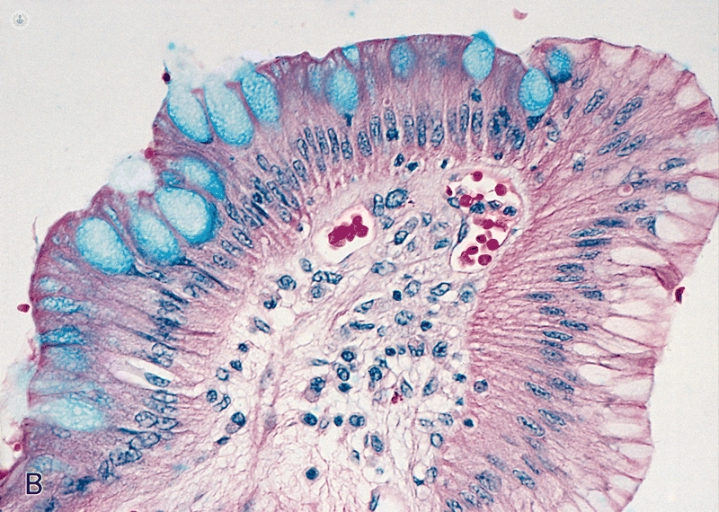What is Barrett's oesophagus?
Barrett's oesophagus (spelt “Barrett’s esophagus” in the US) is a condition in which the tissue that lines the bottom of the oesophagus undergoes a change, usually in response to acid reflux from the stomach. It is a relatively common complication of gastro-oesophageal reflux disease (GORD).
Normally, the oesophagus is lined with squamous epithelial cells. However, exposure to stomach acid regurgitating up into the gullet can inflame and damage the cells. This leads to metaplasia, whereby the cells change into a different kind of cell, in this case columnar cells that are usually found in the lower digestive tract. These cells better resist the stomach acid, protecting the oesophagus.
However, symptoms of reflux can still bother the patient, and in a small number of cases, the cells can become cancerous. For this reason, Barrett’s oesophagus is regarded as a premalignant condition and although the proportion of cases that lead to oesophageal cancer is small, the condition should be monitored once diagnosed.

What are the symptoms of Barrett's oesophagus?
Barrett's oesophagus itself does not produce symptoms. However, it is almost always caused by acid reflux and this can cause a number of other symptoms:
- Heartburn
- Bitter taste in the mouth
- Dysphagia
- Over-production of saliva in the mouth (water brash)
- Chronic dry cough
What are the causes of Barrett's oesophagus?
Barrett’s oesophagus is closely associated with gastric reflux (also known as acid reflux or gastro-oesophageal reflux). This is a phenomenon where stomach acid splashes back up into the oesophagus, usually due to a problem with the ring of muscle that separates the oesophagus from the stomach (the gastro-oesophageal sphincter). If this sphincter loses tone and is unable to close, stomach acid is able to regurgitate back up.
If the patient experiences long-term acid reflux, this is known as gastro-oesophageal reflux disease (GORD). Around 1 in 10 patients with GORD will develop Barrett’s oesophagus.
The exact mechanism that causes Barrett’s oesophagus isn’t fully understood, as not all patients with acid reflux develop the condition.
Can Barrett’s oesophagus be prevented?
Early diagnosis and effective treatment of acid reflux or GORD can significantly reduce the risk of Barrett's oesophagus developing.
What is the treatment for Barrett’s oesophagus?
The first line of treatment for Barrett’s oesophagus involves managing the symptoms of acid reflux. This may involve the following measures:
- Acid-suppressing medication, such as antacids, proton pump inhibitors, etc.
- Avoid tobacco, alcohol and other substances that can affect the oesophagus
- Avoid spicy or acidic food
- Lose weight
Barrett’s oesophagus should be monitored closely via endoscopy to check for signs that the Barrett’s cells are progressing to cancer, in which case they will need immediate treatment.
If the cells become cancerous, the following procedures serve to remove the harmful tissue:
- Radiofrequency ablation – an electrode at the end of an endoscope applies an electrical current to the affected area, destroying the malignant cells, which allows normal cells to grow in their place.
- Endoscopic mucosal resection (EMR) – a thin wire called a snare on the end of an endoscope is used to remove malignant cells.
- Surgical resection - more extensive surgery that may require admission to the ICU. The surgeon removes the affected part of the oesophagus and joins the stomach to the remaining part.
- Photodynamic therapy: It involves the use of a laser device or oesophageal balloon together with a medication.
- Cryotherapy
- Other types of procedures using high energy to destroy cancerous cells.
Barrett's oesophagus
Dr Aathavan Loganayagam - Gastroenterology
Created on: 02-10-2017
Updated on: 10-24-2023
Edited by: Karolyn Judge
What is Barrett's oesophagus?
Barrett's oesophagus (spelt “Barrett’s esophagus” in the US) is a condition in which the tissue that lines the bottom of the oesophagus undergoes a change, usually in response to acid reflux from the stomach. It is a relatively common complication of gastro-oesophageal reflux disease (GORD).
Normally, the oesophagus is lined with squamous epithelial cells. However, exposure to stomach acid regurgitating up into the gullet can inflame and damage the cells. This leads to metaplasia, whereby the cells change into a different kind of cell, in this case columnar cells that are usually found in the lower digestive tract. These cells better resist the stomach acid, protecting the oesophagus.
However, symptoms of reflux can still bother the patient, and in a small number of cases, the cells can become cancerous. For this reason, Barrett’s oesophagus is regarded as a premalignant condition and although the proportion of cases that lead to oesophageal cancer is small, the condition should be monitored once diagnosed.

What are the symptoms of Barrett's oesophagus?
Barrett's oesophagus itself does not produce symptoms. However, it is almost always caused by acid reflux and this can cause a number of other symptoms:
- Heartburn
- Bitter taste in the mouth
- Dysphagia
- Over-production of saliva in the mouth (water brash)
- Chronic dry cough
What are the causes of Barrett's oesophagus?
Barrett’s oesophagus is closely associated with gastric reflux (also known as acid reflux or gastro-oesophageal reflux). This is a phenomenon where stomach acid splashes back up into the oesophagus, usually due to a problem with the ring of muscle that separates the oesophagus from the stomach (the gastro-oesophageal sphincter). If this sphincter loses tone and is unable to close, stomach acid is able to regurgitate back up.
If the patient experiences long-term acid reflux, this is known as gastro-oesophageal reflux disease (GORD). Around 1 in 10 patients with GORD will develop Barrett’s oesophagus.
The exact mechanism that causes Barrett’s oesophagus isn’t fully understood, as not all patients with acid reflux develop the condition.
Can Barrett’s oesophagus be prevented?
Early diagnosis and effective treatment of acid reflux or GORD can significantly reduce the risk of Barrett's oesophagus developing.
What is the treatment for Barrett’s oesophagus?
The first line of treatment for Barrett’s oesophagus involves managing the symptoms of acid reflux. This may involve the following measures:
- Acid-suppressing medication, such as antacids, proton pump inhibitors, etc.
- Avoid tobacco, alcohol and other substances that can affect the oesophagus
- Avoid spicy or acidic food
- Lose weight
Barrett’s oesophagus should be monitored closely via endoscopy to check for signs that the Barrett’s cells are progressing to cancer, in which case they will need immediate treatment.
If the cells become cancerous, the following procedures serve to remove the harmful tissue:
- Radiofrequency ablation – an electrode at the end of an endoscope applies an electrical current to the affected area, destroying the malignant cells, which allows normal cells to grow in their place.
- Endoscopic mucosal resection (EMR) – a thin wire called a snare on the end of an endoscope is used to remove malignant cells.
- Surgical resection - more extensive surgery that may require admission to the ICU. The surgeon removes the affected part of the oesophagus and joins the stomach to the remaining part.
- Photodynamic therapy: It involves the use of a laser device or oesophageal balloon together with a medication.
- Cryotherapy
- Other types of procedures using high energy to destroy cancerous cells.


Barrett's oesophagus: causes, symptoms, and the link to oesophageal cancer
By Dr Matthew Banks
2024-11-20
Expert gastroenterologist Dr Matthew Banks answers questions about Barrett's oesophagus; the causes, diagnosis, treatment and the link to oesophageal cancer. See more


Barrett’s oesophagus: how acid reflux can have nasty consequences
By Professor Stuart Bloom
2024-11-20
What is Barrett's oesophagus? Find out how acid reflux can cause more than just heartburn - it can sometimes alter the cells of the oesophagus, which can lead to more serious problems. See more


Series (Part Three): Living with GORD
By Dr Andrew Thillainayagam
2024-11-20
Managing daily life with GORD, surgical options and its possible complications are explained in part three of this series of articles by consultant physician and gastroenterology specialist, Dr Andrew Thillainayagam and clinical research fellow Dr Neil Galletly. See more


Diet, lifestyle and acid reflux
By Professor Stuart Bloom
2024-11-19
In this informative article on the effects of diet and lifestyle on acid reflux, leading consultant gastroenterologist Professor Stuart Bloom, gives expert insight on the condition's causes and invaluable advice on managing the problem. See more
Experts in Barrett's oesophagus
-
Dr Philip Woodland
GastroenterologyExpert in:
- Endoscopy
- Gastroscopy
- Colonoscopy
- Endoscopic ultrasound (EUS)
- Acid reflux
- Barrett's oesophagus
-
Professor Pradeep Bhandari
GastroenterologyExpert in:
- Barrett's oesophagus
- Acid reflux
- Endoscopy
- Bowel cancer screening
- Irritable bowel syndrome (IBS)
- Obesity
-
Dr Rami Sweis
GastroenterologyExpert in:
- Difficult Swallowing (Dysphagia)
- Gastrointestinal endoscopy
- Constipation
- Diarrhoea
- Barrett's oesophagus
- Achalasia
-
Dr Vinay Sehgal
GastroenterologyExpert in:
- Acid reflux
- Barrett's oesophagus
- Irritable bowel syndrome (IBS)
- Endoscopy
- Cancer screening
- Digestive diseases
-
Professor Khurshid Akhtar
SurgeryExpert in:
- Gallstones
- Laparoscopic hernia surgery
- Hiatal hernia surgery
- Acid reflux
- Barrett's oesophagus
- See all

The Harborne Hospital - part of HCA Healthcare
The Harborne Hospital - part of HCA Healthcare
Mindelsohn Way, B15 2FQ
No existe teléfono en el centro.
By using the telephone number provided by TOP DOCTORS, you automatically agree to let us use your phone number for statistical and commercial purposes. For further information, read our Privacy Policy
Top Doctors

GI DOCTORS
GI DOCTORS
116 Harley Street, Marylebone, W1G 7JL
No existe teléfono en el centro.
By using the telephone number provided by TOP DOCTORS, you automatically agree to let us use your phone number for statistical and commercial purposes. For further information, read our Privacy Policy
Top Doctors

The Princess Grace Hospital - part of HCA Healthcare
The Princess Grace Hospital - part of HCA Healthcare
The Princess Grace Hospital, 42-52 Nottingham Pl, W1U 5NY
No existe teléfono en el centro.
By using the telephone number provided by TOP DOCTORS, you automatically agree to let us use your phone number for statistical and commercial purposes. For further information, read our Privacy Policy
Top Doctors
-
The Harborne Hospital - part of HCA Healthcare
Mindelsohn Way, B15 2FQ, BirminghamExpert in:
- Digestive
- Cancer
- Orthopaedic surgery
- Thoracic Surgery
- Diagnostic Imaging
- Obstetrics and Gynaecology
-
GI DOCTORS
116 Harley Street, Marylebone, W1G 7JL, W1G Marylebone LondonExpert in:
- Colorectal surgery
- Colonoscopy
- Inflammatory bowel disease
- Gastroenterology
- Hernia
- Irritable bowel syndrome
-
The Princess Grace Hospital - part of HCA Healthcare
The Princess Grace Hospital, 42-52 Nottingham Pl, W1U 5NY, Central LondonExpert in:
- Cancer
- General Surgery
- Orthopaedic surgery
- Robotic Surgery
- Intensive care
- Sports Medicine
- See all
- Most viewed diseases, medical tests, and treatments
- Nutrition
- Weight loss injections
- Nipple discharge
- Abdominal pain
- Endovenous laser treatment (EVLA)
- Minimal access surgery (keyhole surgery)
- Head and neck cancer
- Neck lump
- Bariatric surgery
- Acellular dermal matrix (ADM)








